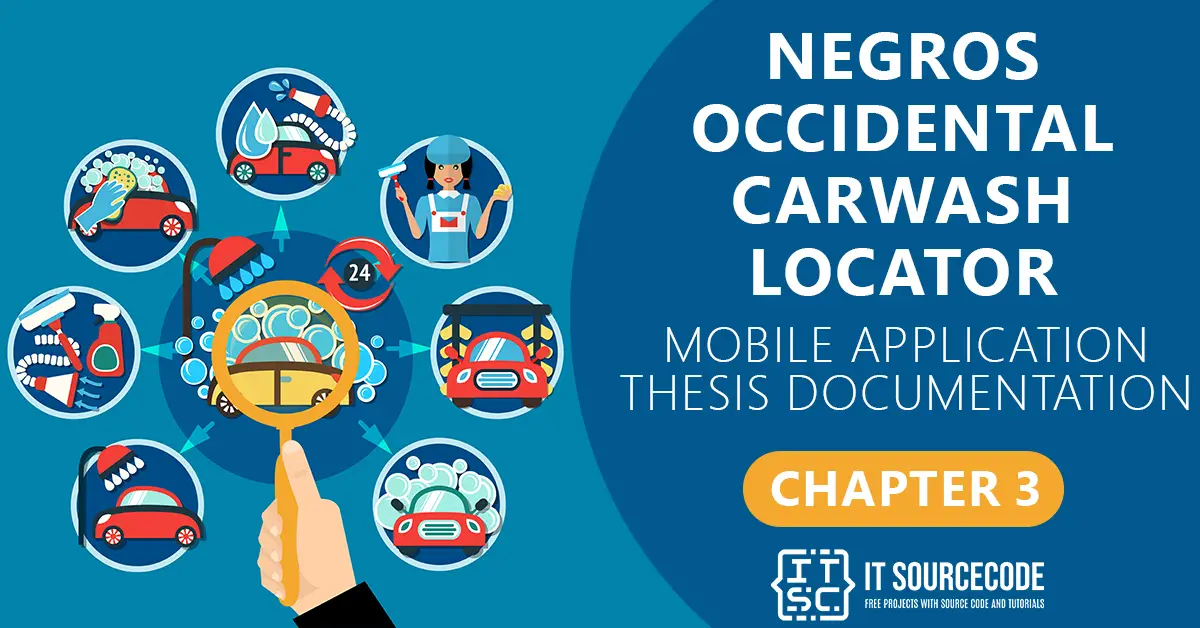NOCL Location Based Mobile Application Chapter 3 | Methodology
This chapter of NOCL Location Based Mobile Application Chapter 3 describe the design and methodology of the system requirements in hardware and software that the android version can adopt or can be used the application developed. This may also help as a basis for the development of the developed system to follow the procedure and make the application meet its main activity.
Here’s the Outline of NOCL Location Based Mobile Application Chapter 3
1. Methodology
2. System Development Life Cycle(SDLC)
3. Context Diagram
4. Dataflow Diagram
5. Decomposition Diagram
6. Use Case
7. Use Case Description
8. Activity Diagram
9. Entity Relationship Diagram
10. Data Dictionary
11. Screen Layout
12. Operational Framework
13. Software Requirements
14. Gantt Chart
15.Time Table
Methodology
This chapter 3 presents the system methodology and design of the proponent’s system
Agile Development Methodology
The proponents used two types of research methods in this study such as the descriptive research and development research, it specifically instead to determine the efficiency and effectiveness of Negros Occidental Carwash Locator Mobile Application System by utilizing both quantitative and qualitative research methodologies and by using the development of technology.
Descriptive research is a valid method for researching specific subjects and as a precursor to more quantitative studies. While there are some valid concerns about the statistical validity, if the limitations are understood by the research, this type of study is an invaluable scientific tool. (Shuttle worth, 2008) On the other hand, Developmental Research has been defined as the systematic study of designing, developing, and evaluating instructional programs, processes, and product that must meet criteria of internal consistency and effectiveness. Developmental research is particularly important in the field of instructional technology. The most common types of developmental research involve situations in which the product-development process is analyzed and described, and the final product is evaluated.
Participants of the Study
The respondents of the study are the Carwash Users Who wanted to search a certain location of Negros Occidental Carwash Locator Mobile Application within their area.
Table 2: Classification and Total Number of Evaluators

Table 2 shows the classification of evaluators and the corresponding number of evaluators per classification. Three Expert group, thirty Owner /users.
Data Gathering Procedure
Data Gathering Instrument is the device use to collect data, such as a paper questioner or computer assisted interviewing system. The instrument signified the importance of is study. The proponents adapted the research instrument through interview and standardized questionnaire. Interview was conducted from random Negros Occidental carwash user. In line with this, the standardized questioner that are used in study evaluates the Negros occidental Carwash Locator in Negros Occidental.
The evaluation instruments used in the study were ISO Software Evaluation for the experts.
ISO Software Evaluation
ISO Software is a set of technical standards documents for the computer software development processes related business management function.
It is one of the point International Organization for Standardization (ISO) and International Electronical Commission (EIC) Standard which use developed by the ISO and EIC join subcommittee, ISO.
Analysis and Procedure Data
After collecting all the survey form, the proponents used an appropriate descriptive statistical tool. The proponents utilized the mean to determine the end users’ collective rating on each criterion.
The frequency and percentages were included to determine the demographic profile of the respondents with the formula:

In interpreting the derived weight mean, the hypothetical range with interpretation was applied.
Table 3: Verbal Interpretation
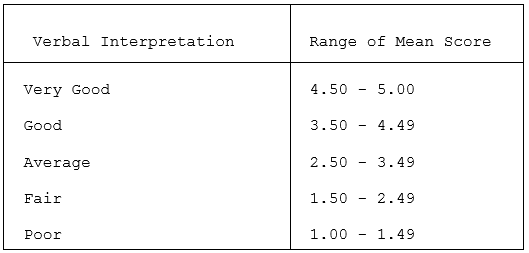
NOCL Location Based Mobile Application Chapter 3 | Methodology : System Development Life Cycle(SDLC)
In this study, the proponents conduct series of test and evaluation to determine how the developed system will perform effectively and meets the requirements of the users. The proponents use some instrument to collect the data needed to evaluate and to interpret the overall satisfaction rates of the users and experts in every criterion given to them.
NOCL Location Based Mobile Application Chapter 3 | Methodology : Agile Development Methodology
The proponents used the agile model as the software development process model in the development of Negros Occidental Carwash Locator Mobile Application.

Figure 1 above shows the model used by the proponents as a guideline in the creating NEGROS OCCIDENTAL CARWASH LOCATOR MOBILE APP. The proponent’s use of agile development methodology to develop the system that allows in changing the requirements when needed to enhance quality assurance and provide all necessary ingredients for development of the system. The believes that the agile software development methodology fit to the proponents developed system.
Initial Planning
In this phase, the proponents conducted an interview. The proponents the staff in the Negros Occidental Carwash Locator Mobile Application System and also research and gather some information about the organization.
Planning
In this phase, the proponents plan on how they will make a system that will lessen the problem of the said company. The proponents research and gather some of information that the other company uses in order to make an ease of access, can obtain accuracy, and lessen the time consuming during some process some process to their company. The proponents collected all information process and to develop the project.
Requirements
In this phase, the proponents do gather information to develop a system. The proponents conducted research and interview to know the needs of the user, defined the scope and limitation.
Analysis and Design
In this phase, the proponents analyzed all ideas had collaborated and discussed the following functions and features of the developed system. It is considering as the manual of the users and output of the project. The proponents gather all possible design to make the prototype of the developed system. The design must be simple so that the user can easily identify the interface of the developed system. In this phase, the proponents use adobe Photoshop to edit the logo and design of the developed system.
Implementation
In this phase, the proponents use programming language is Android Studio, PHP, and MySQL. The coding, testing, operating, and maintaining the system was implementing. The proponents should build was exactly was been requested or suggested, though still there are rooms for innovation and flexibility.
Testing
The proponents conducted system testing and debugging until the final project was fully working. The testing was made to determine if the system meets the requirements needed. A consultation was conducted with the users to determine the usability of the developed system.
Evaluation
In this phase the system needed to be evaluated before the next agile procedure. The evaluation is conducted with the different employees of Negros Occidental Carwash Locator Mobile Application System such as the admin, users, and company owner.
Deployment
In this phase, the project is totally functioning and ready to deploy and use by the user, the proponents conduct a survey to evaluate were system tested by the user or drivers, that can we know what the user’s opinion that could be possible to add.
NOCL Location Based Mobile Application Chapter 3 | Methodology : Context Diagram
The context diagram shows the process of the programs using the developed system and the sequence of Negros Occidental Carwash Locator Mobile Application System.

Figure 2 above shows the sequence of the Negros Occidental Carwash Locator Mobile Application that being process dated to the user can search a Carwash Station adding the application and it can provide the list of Carwash Station. The company owner can add this carwash station and updating us availability the admin can manage and verify all activities of the company owner.
NOCL Location Based Mobile Application Chapter 3 | Methodology : Data flow Diagram
A data flow diagram of Negros Occidental Carwash Locator Mobile Application System. Shown In figure is represent the flow of the system throughout the process, this system will show what kind of information well be input and where the data will go and how it is stored, this diagram how the systems function.
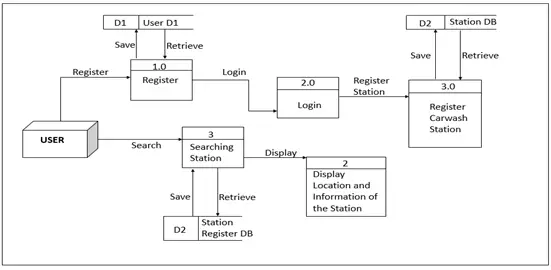
Figure 3 Data Flow Diagram shows the data flow of all the concept and the process of each entities it shows the process in the developed system solution showing this flow may help the reader for identifying in which the process begins.
NOCL Location Based Mobile Application Chapter 3 | Methodology : Decomposition Diagram
Decomposition diagram shows a high function. Process, organization, data subject area, or other type of object broken down into lower-level, more detailed components of carwash locator.

Figure 4 above shows the decomposition chart of the Negros Occidental Carwash Locator App. Its show the breakdown of the list of items into or group on the starting point of the function each item performs.
NOCL Location Based Mobile Application Chapter 3 | Methodology : Use Case Diagram
A use case diagram as its simplest is a representation of a user’s interaction with the system. Use case diagrams illustrate the functionality of a system using the actors and use cases.

Figure 5 shows the use case diagram of the Negros Occidental Carwash Locator Mobile Application System. Show the interaction of user in the application. The diagram was developing to visualize the process that the user performs in every use case and how the user and company owner use the application.
NOCL Location Based Mobile Application Chapter 3 | Methodology : Use Case Description
Use case description show how to work the whole system consist of sign-up, log-in, adding new carwash station, update of carwash station status, search location, information of carwash station status.
Table 4: Sign up
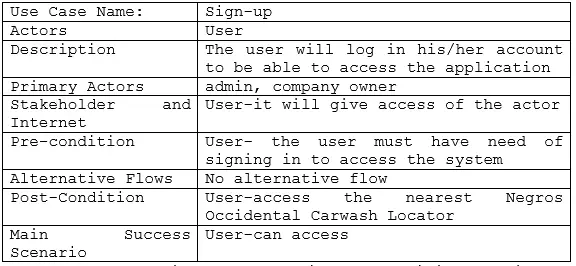
Table 4 describes the functions of entities of sign-up in the system Negros Occidental Carwash Locator Mobile Application.
Table 5: Log-in

Table 5 describes the functions of entities or log in of the user to the application in the system Negros Occidental Carwash Locator Mobile Application.
Table 6: Search for Carwash Station

Table 6 describes the functions of entities or Search for Carwash Station of the user to the application in the system Negros Occidental Carwash Locator Mobile Application.
Table 7: Add Carwash Station

Table 7 describes the functions of entities or Add Carwash Station of the user to the application in the system Negros Occidental Carwash Locator Mobile Application.
Table 8: Location

Table 8 describes the function of entities of the location used of users to the system Negros Occidental Carwash Locator.
Table 9: Information of carwash status

Table 9 describes the function of entities of how the user & Carwash Company-owner view Carwash Location information in the system Negros Occidental Carwash Locator.
Table 10: Add Rate

Table 10 describes the function of entities of how the user add rate in the system Negros Occidental Carwash Locator.
NOCL Location Based Mobile Application Chapter 3 | Methodology : Activity Diagram
The activity Diagram of Negros Occidental Carwash Locator Mobile Application System.
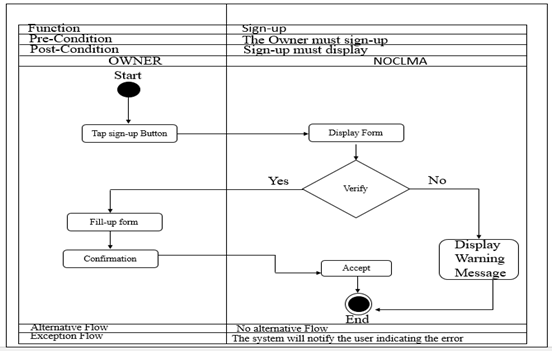
Figure 6 above shows the activity diagram for the sign-up show the execution activity when the owner registration to access in the application.

Figure 7 above shows the activity diagram for the log-in show the execution activity when the owner registration to access in the application.
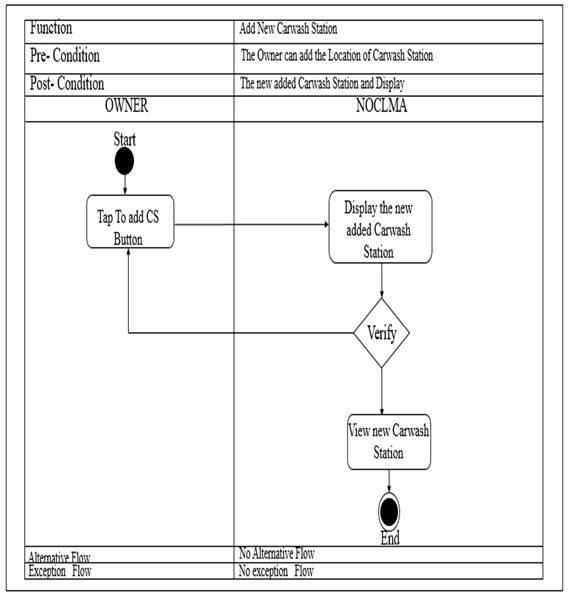
Figure 8 above shows the activity diagram for adding new carwash station shows the execution of activity when the owner wants to add new carwash station.
NOCL Location Based Mobile Application Chapter 3 | Methodology : Entity Relationship Diagram
An entity relationship diagram is a graphical representation that includes all the entities in the system and their corresponding relationships.

Figure 9 Shows the entity relationship diagram Negros Occidental Carwash Locator. It includes the entities in the system and the relationships of entity sets stored in the database.
NOCL Location Based Mobile Application Chapter 3 | Methodology : Data Dictionary
The data dictionary of Negros Occidental Carwash Locator contains the tables used in the system’s database. It is a set of information describing the contents and format of the database. It includes the field name, data type and default value.
Table: 11 tblfavorite

Table 11 shows the data dictionary of the favorite table. The table contains the Favorite ID, Custid, Carwash no, f_vehicle, and their corresponding description type, and length.
Table: 12 tblextra

Table 12 shows the data dictionary of the extra table. The table contains the Extraid, Service id, e name, e Price, and their corresponding description, type and length.
Table: 13 tblreserve

Table 13 shows the data dictionary of the reserve table. The table contains the reserveid, Reserve_no, extraname,extraid and their corresponding description, type and length.
Table: 14 tblrate

Table 14 shows the data dictionary of the rate table. The table contains the rateid, custid, carwash_no, rate, r_desc and their corresponding description, type, and length.
Table: 15 Auto Number Database Table
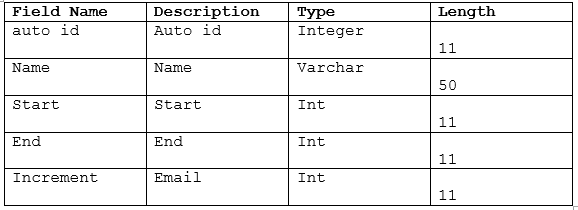
Table 15 shows the data dictionary of the auto Number table. The table contains the Auto Id, Name, Start, End, Increment.
Table: 16 Servicedetailed Database Table

Table 16 shows the data dictionary of the service detailed table. The table contains the Detailed Id, Reserve Date, Customer id, Arrival, Time Arrival, Vehicle id, Carwash_no, Service id, Reserve no, Total, Message, Owner id, Status date, Date status.
Table: 17 Owner Database Table

Table 17 shows the data dictionary of the owner table. The table contains the Owner id, Fname, Lname, Contact, Birthdate, Address, Email, Password, Image.
Table: 18 Customer Database Table

Table 18 shows the data dictionary of the customer table. The table contains the Cust id, Fname, Lname, Contact, Birthdate, Address, Email, Password, Image.
Table: 19 Carwash Database Table
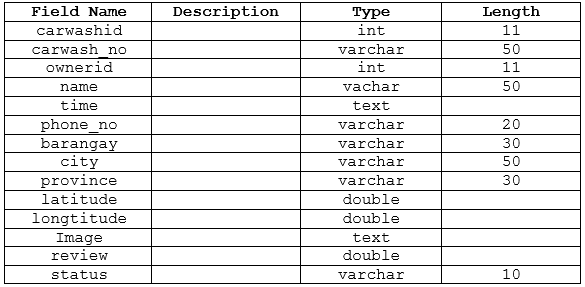
Table 19 shows the data dictionary of the customer table. The table contains the carwashid, carwash_no, ownerid, name, time, phone_no, barangay, city, province, latitude, longtitude, Image, review, status.
Table: 20 USER Database Table

Table 20 shows the data dictionary of the user table. The table contains the userid, fname, lname, email, contact, username, password.
Table: 21 Vehicle Database Table

Table 21 shows the data dictionary of the vehicle table. The table contains the vehicle_id, custid, v_type, brand, model, color.
Table: 22 Services Database Table
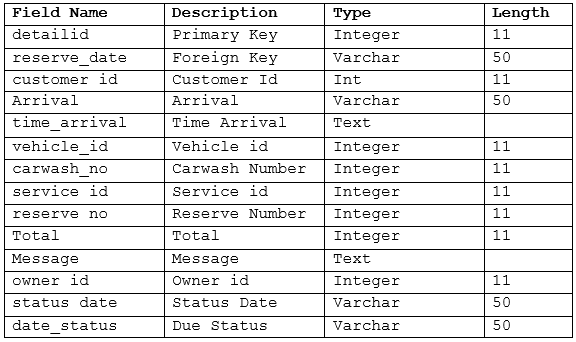
Table 22 shows the data dictionary of the services table. The table contains the service_id, carwash_no, vehicle, ptype, pname, pack_service, price and description.
NOCL Location Based Mobile Application Chapter 3 | Methodology : Screen Layout
The screen layout of the Carwash locator System gives the users an overview of how the interface of what system looks like and what functions are included in the system. This can help them become familiar with the system’s interface and provide support in the development of the project.
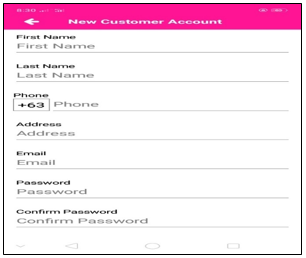
Figure 10 shows the User Registration form of Negros Occidental Carwash Locator System.

Figure 11 shows the Menu Page of Negros Occidental Carwash System.
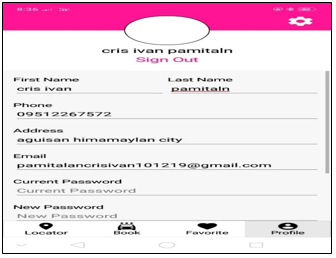
Figure 12 shows the User Account Details Page Negros Occidental Carwash Locator System.
NOCL Location Based Mobile Application Chapter 3 | Methodology : Operational Framework
Operational framework shows about the process using Negros Occidental Carwash Locator Mobile Application. The user interacts with the interface of application using their android phone when the user uses the application they need to check the internet connection first before they can access the map Locator using GPS. The application is to be use by the people who searching Negros Occidental Carwash Locator Mobile Application like private driver or drivers are not familiar in the place.
The workflow in using the Negros Occidental Carwash Locator Mobile Application is composing of user or client and company owner, Smartphone, and internet. It is stored in the database and retrieves from the database.

Figure 13 Shows the operational framework of Negros Occidental Carwash Locator Mobile application. The system components include the user, mobile app, internet, admin and database. The users can register using android phones and connected to internet. The admin checks user’s information through internet and the user’s information to be saved to the database. The admin views all transactions through the system.
Hardware and Software :
Processor: Core I3 or higher, 7th Generation or Higher
RAM: 2 GB Space on disk (at least)
For running on a device:
Device :
Phone or tablet running Android Jellybean or Higher version
Disk space: 30 MB (at the least)
Processor: Dual Core (at the least)
NOCL Location Based Mobile Application Chapter 3 | Methodology : Software Requirements
The proponent used the following software requirements for
The development of Negros Occidental Carwash Locator Mobile Application.
For development:
Operating System: Windows 10 or higher version
Platform: Android SDK Framework 10 or higher version
Software used: MS Word, Paint, Google Maps v2 API, Php,
JavaScript, MySQL
IDE: B4A
Platform: Android
Text Editor: Sublime Text Android SDK: API level 10 or higher version
For running on a device:
Operating System: Android Jellybean or higher version of
Mobile phone or tablet with the capacity to accept an inbound
And outbound call.
NOCL Location Based Mobile Application Chapter 3 | Methodology : Gantt chart
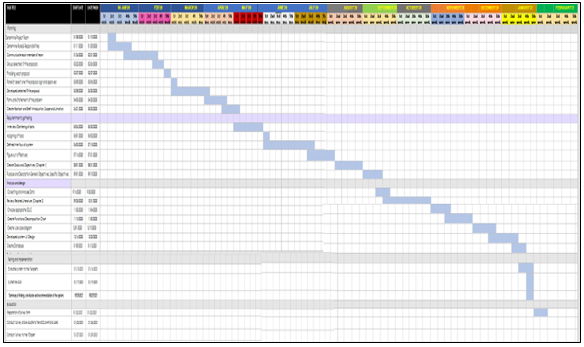
Figure 14: Gantt chart
A Gantt chart is a tool used for project time management. It presents the project schedule which includes the activities and their respective start date, end date, duration, and dependencies. The proponents used the Gantt chart to plan, coordinate, and track project activities.
NOCL Location Based Mobile Application Chapter 3 | Methodology : Timetable
The timetable presents the sequence of the tasks done during the development of the system. It also shows the date Started, date finished, and assigned members for each task.
Table: 23 Timetable

Related Article
- NOCL Location Based Mobile Application Thesis Documentation Chapter 1
- NOCL Location Based Mobile Application Chapter 2
- Pharmacy Management System Thesis | Chapter 3 – Methodology
- Online Restaurant Management System Documentation Chapter 3
- Sales and Inventory System Documentation Chapter 3
- Library Borrowing System Documentation | Chapter III – Methodology
- Attendance Monitoring System Documentation | Chapter 3
Inquiries
if you have any questions or suggestions about NOCL Location Based Mobile Application Chapter 3 | Methodology, please let’s me know by dropping your comment below.

